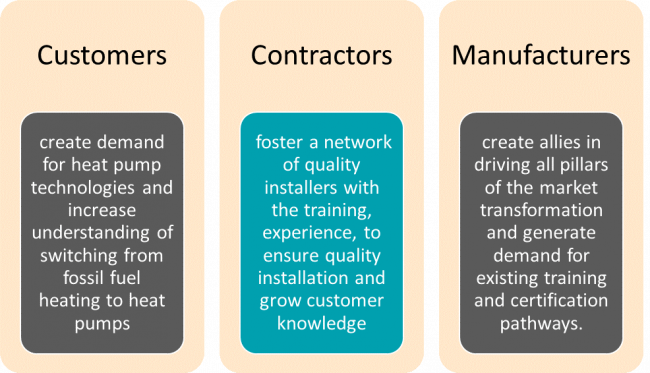

By Erin Cosgrove | Tue, October 26, 21
Energy efficiency programs have long operated with a goal of lowering energy use in buildings. But with the right policy, energy efficiency programs can go further and lay the foundation for a more equitable, decarbonized economy. Recent legislation in Massachusetts, S9 - An Act Creating a Next Generation Roadmap for Massachusetts (Climate Act), started this transformation. Since the law has been enacted, Massachusetts program administrators (PAs) have been writing the next MassSave Energy Efficiency Plan (2022 – 2024). This blog will walk through changes in electrification, equity, and workforce policy from the April draft plan to the September rewrite that resulted from the Climate Act.
Jumpstarting Beneficial Electrification with Metrics
The first change in the two draft plans is the discussion and framing of electrification. Massachusetts has one of the top-performing energy efficiency program portfolios, but is still figuring out how to tackle electrification. The Climate Act changed this with metrics. By mandating the use of climate metrics, calling for a GHG goal, and including the social cost of carbon in the cost-benefit test, program goals shifted from lowering energy to lowering GHG.
- Creating a GHG Goal: By using GHG emissions as the goal instead of energy consumption, energy efficiency plans will directly align with state climate policy. The Climate Act directs the Secretary of Energy and Environmental Affairs to set a yearly annual CO2e avoided (metric tons) goal for energy efficiency plans. A CO2e goal measures what is known as “carbon dioxide equivalent,” estimating the impacts from carbon dioxide and other greenhouse gases. This new goal directly resulted in 57.9 percent more emissions reductions in the electricity sector from the April to the September draft plan. This goal also advances beneficial electrification policy because it recognizes that emissions from electricity will “become cleaner as more renewable generation comes online” while fossil fuel emissions remain the same.
- Including the Social Cost of Carbon: Similar to setting a GHG goal, accounting for climate air emissions puts policy directly into the energy efficiency planning process. The Climate Act mandates that energy efficiency plans include the societal costs of carbon emissions. The PAs noted this change has allowed them to prioritize GHG emissions-reducing projects. A review of the September draft of the plan shows how impactful this change is, as it now includes:
-
- Enhanced incentives that will cover 80 percent of installed costs for heat pump systems, including fuel switching.
- Increased focused on heat pumps paired with weatherization and active demand reduction to lower costs for consumers.
- New initiatives in the commercial and residential sectors to increase weatherization and heat pump adoption, including a new three pillar approach to scale up residential adoption (pictured on the right) and the Deep Energy Retrofit program to provide technical and financial assistance for business to manage energy investments and usage in a holistic manner.
Centering Equity and Environmental Justice Communities with Definitions
The next change is the program design and resources dedicated to environmental justice communities. In recent years, energy efficiency plans have begun to more deeply address equity issues as the energy industry and policymakers better understand the importance of centering equity and undoing past injustices. In Massachusetts, the Climate Act contributed to this effort by codifying the definition of an environmental justice community. A statewide definition is able to guide and inform work in every sector across the state.
In energy efficiency plans, PAs the have identified 38 communities as environmental justice communities and increased efforts to reach these communities and invest in them. The most notable of which is the transformation of the Municipal & Community Partnership Strategy to the Community First Partnership Program. The Community First Partnership Program has been created to focus on increasing program participation rates and engagement with environmental justice communities through numerous new engagement strategies, including:
- Increasing the number of community partner teams that work with community-based organizations (CBOs) and provisioning a financial incentive for these partnerships;
- Creating an energy advocates program to build long-term local knowledge of energy efficiency offerings through development of community-based energy advocates. These advocates will be compensated and trained, and will help coordinate with the PAs to create programs that overcome participation barriers; and
- A new focus on data at the community level that includes training on available data resources and regular access to achievement data that can inform community partner team outreach strategies.
While this blog focused on changes as a result of the Climate Act, it is important to note that in May 2020, the Massachusetts Energy Efficiency Advisory Council created an equity working group to identify and recommend priority actions, plans, and partnerships to increase participation across all underserved customers. This effort can also be seen in many changes throughout the energy efficiency plans.
Creating an Inclusive Clean Energy Workforce with a Meaningful Investment
The final change is the design of a comprehensive and inclusive workforce program. Underpinning every energy efficiency program is a community of companies and workers who have numerous new opportunities as these programs grow. But without proper policy, workforce programs may perpetuate inequities. Research on diversity in the U.S. energy workforce shows that the energy sector has below-average representation of Hispanic and Black workers, and gender gaps exist as well.
The Climate Act starts to tackle this issue in two ways: 1) it requires a yearly investment of $12 million from the utilities to the Massachusetts Clean Energy Center (MassCEC) to create a Clean Energy Equity Workforce and Market Development Program and 2) it creates a heat pump market development program. The result is a substantial change in the workforce portion of the plan’s proposal to create a comprehensive clean energy workforce that supports and is accessible to individuals and businesses across the state.
- To increase electrification, the PAs have proposed a new initiative to foster a network of quality heat pump installers, the Electric HVAC Participating Heat Pump Installer Network. The program will focus on recruitment, training, and long-term creation of a network of heat pump HVAC contractors. In addition, the electrification workforce initiative includes a codes and standards compliance and technical support initiative (CSCS) that will provide education and outreach to reduce gaps in energy code compliance.
- To ensure an inclusive energy efficiency workforce and industry, the PAs have created a Clean Energy Pathway Program to prioritize training and certification completion rates in environmental justice communities. This program will include scholarships to alleviate financial hardships and increase access to energy efficiency training and certification programs. The program aims to alleviate all participation barriers and ensure that workers are trained and advance their careers in energy efficiency.
What’s Next?
With legislative sessions winding down, now is the time to plan for what we would like to see next year. At NEEP, we are hoping for more commitments to tying climate goals to energy efficiency plans, legislation that empowers underserved communities, and workforce opportunities that invest in individuals and communities.


